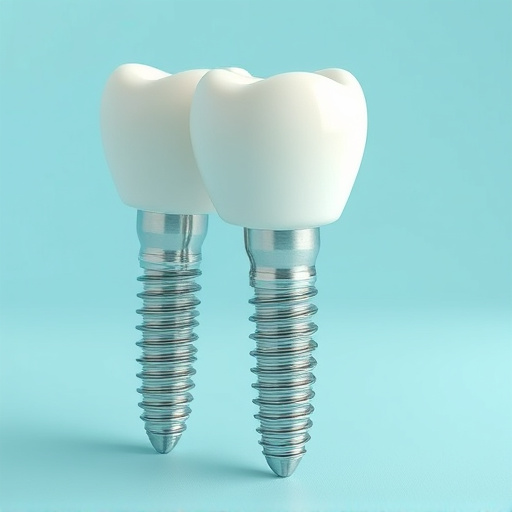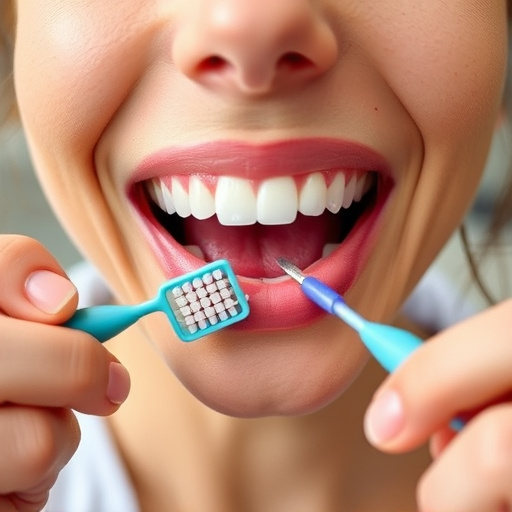All on Four Implants: Fewer Appointments, Restored Smile
All on Four dental implants represent a revolutionary, efficient solution for missing teeth, utilizi…….
Welcome to an in-depth exploration of a groundbreaking dental procedure: the All-on-Four dental implant system. This innovative approach has transformed the way we address tooth loss, offering a durable and aesthetically pleasing solution for those seeking full mouth restoration. In this comprehensive article, we will navigate through various facets of All-on-Four implants, from their technical aspects to global impact, economic implications, and future prospects. By the end, readers will grasp the significance of this procedure and its potential to reshape oral healthcare globally.
Definition: All-on-Four dental implants represent a state-of-the-art solution for replacing multiple missing teeth in both the upper and lower jaws. As the name suggests, this technique utilizes just four strategically placed implants to support a full set of functional and natural-looking artificial teeth.
Core Components:
Historical Context: The concept of using dental implants for full mouth rehabilitation is not new. However, the All-on-Four system emerged as a game-changer in the 1970s when a Swedish dentist, Dr. Carl E. Lindhe, pioneered this technique. Over time, advancements in materials science and surgical techniques have refined the process, making it more accessible and successful than ever.
Significance: All-on-Four implants offer several advantages over traditional methods:
| Benefits | Description |
|---|---|
| Improved Comfort and Function | Provides a secure, stable bite allowing patients to chew efficiently and speak clearly. |
| Aesthetic Appeal | Offers a natural-looking solution that blends seamlessly with surrounding teeth. |
| Bone Preservation | Stimulates the jawbone through implant integration, preventing bone loss commonly associated with tooth loss. |
| Longevity | With proper care, implants can last a lifetime, eliminating the need for frequent replacements. |
| Versatility | Suitable for patients missing one to several teeth in either arch. |
The All-on-Four dental implant system has captivated dental professionals and patients worldwide, leading to its widespread adoption and global influence.
Regional Adoption:
Key Trends Shaping the Landscape:
| Trends | Impact |
|---|---|
| Minimally Invasive Techniques: Modern surgical approaches focus on reducing procedure time and patient discomfort while enhancing precision. | Increased patient satisfaction and faster recovery. |
| Digital Technology: 3D imaging, CAD/CAM (Computer-Aided Design/Manufacturing), and virtual planning enable highly accurate implant placement and personalized prostheses. | Improved outcomes and reduced revision rates. |
| Biomaterials Advancements: Newer titanium alloys and surface treatments enhance osseointegration (bone integration) and biocompatibility. | Increased implant stability and reduced risk of rejection. |
| Remote Consultation and Treatment: Telehealth services allow patients in remote areas to access expert opinions, leading to increased accessibility. | Broader patient reach and improved global healthcare equity. |
The economic implications of All-on-Four dental implants are significant, impacting both the dental industry and healthcare systems worldwide.
Market Dynamics:
Investment Patterns:
Economic Impact:
The field of All-on-Four dental implants has been characterized by relentless innovation, driving its success and future potential.
Recent Breakthroughs:
| Advancement | Description |
|---|---|
| Computer-Aided Surgery (CAS): This technology guides surgeons during the placement process, ensuring precise implant positioning and reducing surgical time. | Enhances accuracy and patient safety. |
| 3D Printing in Implant Design: Customized implants and abutments can be printed to exact specifications, allowing for enhanced fit and esthetics. | Reduces manufacturing time and costs while improving patient outcomes. |
| Smart Materials: Developing biomaterials with integrated sensors offer real-time feedback on implant health, bone density, and patient chewing forces. | Enables proactive dental care and potential predictive maintenance. |
| Digital Prosthetics: CAD/CAM technology now extends beyond abutments to create highly precise, computer-designed dental crowns, further enhancing aesthetics. | Elevates the overall quality of the final restoration. |
Future Potential:
The regulation of dental implants is crucial for ensuring patient safety, quality care, and ethical practices.
Key Policies and Frameworks:
Impact on All-on-Four Implantation:
Despite its numerous advantages, All-on-Four dental implants face challenges that require strategic solutions.
Common Issues:
| Challenge | Description | Strategic Solutions |
|---|---|---|
| High Initial Cost: The procedure’s complexity contributes to elevated costs, making it less accessible for some patients. | Provide financial assistance programs and insurance coverage options to bridge the gap. | |
| Surgical Complexity: Requires skilled surgeons; complications can arise, leading to longer recovery times and higher risks. | Enhance training programs and encourage collaboration between general dentists and specialist surgeons. | |
| Patient Selection: Not suitable for all patients due to medical conditions or bone density. | Develop comprehensive patient screening protocols and explore alternative solutions for high-risk cases. | |
| Long-Term Maintenance: Regular care is essential to prevent complications; compliance can be challenging for some patients. | Educate patients on post-implant care and integrate these procedures into routine dental hygiene practices. |
Case Study 1: Restoring a Smile in Europe
A 62-year-old female patient from Germany presented with advanced tooth loss, affecting her ability to chew and speak clearly. Through a comprehensive assessment, Dr. Schmidt determined that All-on-Four implants were the ideal solution. The procedure was successfully completed, and within months, the patient’s quality of life improved significantly. She now enjoys robust chewing function and a natural-looking smile, free from the discomfort of ill-fitting dentures.
Case Study 2: Transforming Oral Healthcare in Rural India
In a remote village in India, Dr. Singh introduced All-on-Four implants to address the region’s lack of dental care. By partnering with local health authorities and using tele-dental services, he provided this advanced treatment to over 50 patients. The initiative not only improved oral health but also empowered local dentists to perform complex procedures, enhancing their capabilities.
Case Study 3: Overcoming Complexities in the USA
A 58-year-old American patient with a history of periodontal disease and low bone density required a delicate All-on-Four placement. Dr. Johnson, an experienced implant surgeon, successfully navigated these challenges through advanced computer-aided planning and precise surgical techniques. The patient’s positive outcome highlighted the importance of tailored treatment plans and expert execution.
The future of All-on-Four dental implants is filled with promise, driven by technological advancements, changing patient preferences, and a growing global need.
Emerging Trends:
Growth Areas:
Strategic Considerations:
All-on-Four dental implants have emerged as a transformative force in oral healthcare, offering unparalleled solutions for patients facing multiple tooth loss. Through its core components, historical development, global impact, economic considerations, technological advancements, regulatory frameworks, and successful case studies, this procedure has proven its worth. As we look ahead, the future prospects are promising, with potential breakthroughs in personalized medicine, miniaturization, and integration with smart technologies.
As dental professionals and patients alike embrace All-on-Four implants, it becomes a cornerstone of modern dentistry, improving lives and redefining oral healthcare standards worldwide. This article aims to provide valuable insights into this revolutionary procedure, encouraging further exploration and discussion within the dental community and beyond.
Q: What are the risks associated with All-on-Four implants?
A: Like any surgical procedure, there are potential risks, including infection, nerve damage, and implant failure. However, these can be minimized through proper patient selection, skilled surgical execution, and meticulous post-operative care. Regular follow-ups are essential to monitor healing and address any concerns promptly.
Q: How long do All-on-Four implants last?
A: With proper maintenance, All-on-Four implants can last a lifetime. Regular dental check-ups, good oral hygiene, and avoiding excessive biting forces contribute to their longevity. The prosthesis (bridges or dentures) attached to the implants also requires periodic replacement for optimal fit and esthetics.
Q: Can All-on-Four implants be used for single tooth replacements?
A: While primarily designed for multiple tooth loss scenarios, All-on-Four implants can be adapted for individual tooth replacements, especially in cases where traditional solutions like dental crowns or bridges are not suitable. This approach offers a more stable and long-lasting alternative to single-tooth dentures.
Q: Are there any alternatives to All-on-Four implants?
A: Yes, other options include traditional fixed bridges, removable partial dentures, and dental implants supporting individual crowns. However, All-on-Four implants offer several advantages, including improved comfort, better bone preservation, and a more natural appearance. The choice depends on individual patient needs, medical history, and preferences.
Q: How do I know if All-on-Four implants are right for me?
A: A comprehensive dental evaluation is crucial. Consult with a qualified dentist who can assess your oral health, jawbone density, and overall medical condition. They will determine if you’re a suitable candidate based on these factors and discuss the benefits and potential risks of the procedure.

All on Four dental implants represent a revolutionary, efficient solution for missing teeth, utilizi…….

The text discusses the evolving approach to dentistry, emphasizing a patient-centric mindset that pr…….